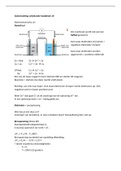TEST BANK FOR INTRODUCTION TO DIAGNOSTIC MICROBIOLOGY FOR
IIll IIll IIll IIll IIll IIll IIll IIll
THE LABORATORY SCIENCE 2ND EDITION
IIll IIll IIll IIll IIll
I I l l BY MARIA DANNESSA DELOST
I I l l IIll IIll
| Verified Chapter's 1 - 24 | Complete
IIll IIll IIll I Ill IIll IIll IIll
,TABLE OF CONTENTS IIll IIll
Chapter 1 Taxonomy, the Microbial Cell, Metabolism, and Genetics……………………………………3
IIll IIll IIll IIll IIll IIll
Chapter 2 Safety in the Clinical Microbiology Laboratory……………………………………………….9
IIll IIll IIll IIll IIll
Chapter 3 Host and Microorganism Interactions………………………………………………………….14
IIll IIll IIll
Chapter 4 Specimen Collection and Management………………………………………………………..20
IIll IIll IIll
Chapter 5 Microscopy, Staining, and Direct Examination of Specimens…………………………………27
IIll IIll IIll IIll IIll IIll
Chapter 6 Traditional Culture and Identification Methods…………………………………………………31
IIll IIll IIll IIll
Chapter 7 Immunochemical and Molecular Methods……………………………………………………….36 IIll IIll IIll
Chapter 8 Antimicrobial Agents and Susceptibility Testing………………………………………………..41
IIll IIll IIll IIll
Chapter 9 Staphylococci and Other Catalase-Positive Gram-Positive Cocci………………………………..47
IIll IIll I I ll IIll IIll
Chapter 10 Streptococcus, Enterococcus, and Related Organisms…………………………………………51
IIll IIll IIll IIll
Chapter 11 Neisseria…………………………………………………………………………………………61
Chapter 12 Enterobacteriaceae………………………………………………………………………………66
Chapter 13 Nonfermentative Gram-Negative Bacilli and Similar Bacteria…………………………………73 IIll IIll IIll IIll II ll
Chapter 14 Vibrio, Aeromonas, Campylobacter, and Similar
IIll IIll IIll IIll
Organisms…………………………………...79
II ll
Chapter 15 Haemophilus, HACEK, Legionella, Bordetella, and Other Fastidious Gram-Negative
II ll IIll IIll IIll IIll II ll IIll
Bacilli...85
IIll
Chapter 16 Gram-Positive Bacilli…………………………………………………………………………..92 IIll
Chapter 17 Spirochetes………………………………………………………………………………………98
Chapter 18 Anaerobes………………………………………………………………………………………102
Chapter 19 Mycobacterium…………………………………………………………………………………110
Chapter 20 Chlamydia, Rickettsia, Mycoplasma, and SimilarIIll IIll IIll IIll
Organisms…………………………………116
II ll
Chapter 21 Introduction to Clinical Mycology……………………………………………………………..121
IIll IIll IIll
Chapter 22 Introduction to Clinical Parasitology…………………………………………………………..128
IIll IIll IIll
Chapter 23 Introduction to Clinical Virology……………………………………………………………..137
IIll IIll IIll
Chapter 24 Clinical Specimens and Infections……………………………………………………………..144
IIll IIll IIll
,Import Settings: IIll
Base Settings: Brownstone Default
IIll IIll IIll
Information Field: Complexity
I I l l IIll IIll
Information Field: Ahead
I I l l IIll IIll
Information Field: Subject
IIll IIll IIll
Information Field: Title
I I l l IIll IIll
Information Field: Feedback IIll IIll
Information Field: Taxonomy
I I l l IIl Il
Information Field: Objective
I I l l IIll IIll
Highest Answer Letter: D
I I l l IIll IIll IIll
Multiple Keywords in Same Paragraph: No IIll IIll IIll IIll IIll
NAS ISBN13: 9781284202212, add to Ahead, Title tags
IIll IIll IIll IIll IIll IIll IIll
Chapter: Chapter 01 - Quiz IIll IIll IIll IIll
Multiple Choice IIll
1. Which of the following is a phenotypical characteristic used for classifying bacteria?
IIll IIll IIl IIll IIll IIll IIll IIll IIll IIll IIll
A) Staining characteristics IIll
B) Macroscopic morphology IIll
C) Nutritional needs IIll
D) All of these are IIll IIll IIll
correct. Ans: D
IIll IIll IIll
Complexity: Easy IIll
Ahead: Classification and Taxonomy IIll IIll IIl
Subject: Chapter 1
I I l l IIll IIll
Title: Taxonomy, the Microbial Cell, Metabolism, and Genetics
IIll IIll IIll IIll IIll IIll IIll
Taxonomy: Recall
I I l l IIll
2. Which of the following is written correctly using the binomial system of nomenclature?
IIll IIll IIl IIll IIll IIll IIll IIll IIll IIll IIl l IIll
A) STAPHYLOCOCCUS aureus
IIll IIll
B) Streptococcus pyogenes
IIll IIll
C) Staphylococcus Epidermidis IIll
D) enterococcus faecalis IIll
Ans: B
II ll IIll
Complexity:Moderate
IIll
Ahead:Classification andTaxonomy IIll Il
Subject: Chapter 1
I I l l IIll IIll
Title: Taxonomy, the Microbial Cell, Metabolism, and Genetics
IIll IIll IIll IIll IIll IIll IIll
Taxonomy:Application
I I l l
3. The bacterial cell: IIll IIll
A) does not have any organelles. IIll IIll IIll IIll
B) contains DNA within the cytoplasm. IIll IIll IIll IIll
C) contains 40S and 60S ribosomal subunits. IIll IIll IIll IIll IIll
, D) has double-stranded DNA that is bound to
IIll IIll IIll IIll IIll IIll
histones. Ans: B
IIll I I l l IIll
Complexity:Moderate
Ahead:Bacterial Components
IIll IIll
Subject: Chapter 1
I I l l IIll IIll
Title: Taxonomy, the Microbial Cell, Metabolism, and Genetics
IIll IIll IIll IIll IIll IIll IIll
Taxonomy:Recall
I I l l
4. Which of the following extensions enable the bacterial cell to attach to host cells?
IIll IIll IIl IIll IIll IIll IIll IIll IIll IIll IIll IIll IIll
A) Flagella
B) Pili
C) Plasmids
D) Ribosomes
Ans: B
IIll IIll
Complexity:
IIll
Easy
IIll
Ahead: Bacterial ComponentsIIll IIll
Subject: Chapter 1
I I l l IIll IIll
Title: Taxonomy, the Microbial Cell, Metabolism, and Genetics
IIll IIll IIll IIll IIll IIll IIll
Taxonomy: Recall
I I l l IIll
5. The gram-positive cell wall contains all of the following, except:
IIll IIll IIll IIll IIll IIll IIll IIl IIll
A) O antigen.
IIll
B) peptidoglycan.
C) teichoic acids. IIll
D) lipoteichoic
acids. Ans: A
IIll I I l l IIll
Complexity:Moderat
IIll
e
Ahead:Bacterial Components IIll
Subject: Chapter 1
I I l l IIll IIll
Title: Taxonomy, the Microbial Cell, Metabolism, and Genetics
IIll IIll IIll IIll IIll IIll IIll
Taxonomy:Application
I I l l
6. Exotoxins:
A) are secreted by gram negative bacteria.
IIll IIll IIll IIll IIll
B) may be extracellular enzymes.
IIll IIll IIll
C) consist of LPS. IIll I Il l
D) can induce fever upon cell lysis.
IIll Il IIll IIll IIll
Ans:B
II l l
Complexity:Moderate
Ahead:Bacterial Components
IIll IIll
Subject: Chapter 1
I I l l IIll IIll
Title: Taxonomy, the Microbial Cell, Metabolism, and Genetics
IIll IIll IIll IIll IIll IIll IIll
Taxonomy:Application
I I l l
7. Gram-positive bacteria contain , which are not found in gram-negative bacteria. IIll IIll IIll IIll IIll IIll IIll IIll IIll
A) capsules
B) periplasmic space and an outer membrane IIll IIll IIll IIll IIll
C) teichoic acids IIll





